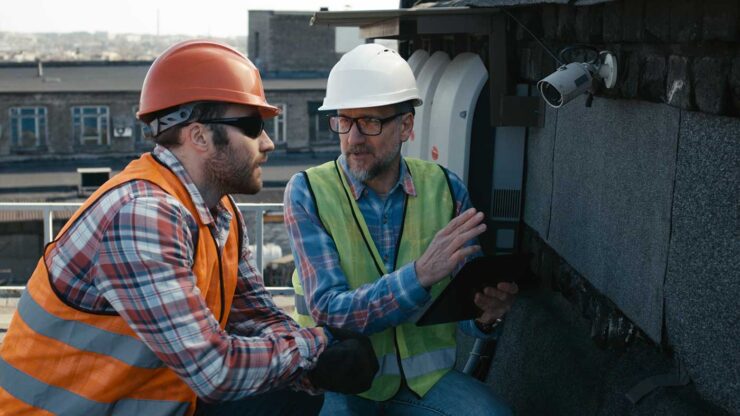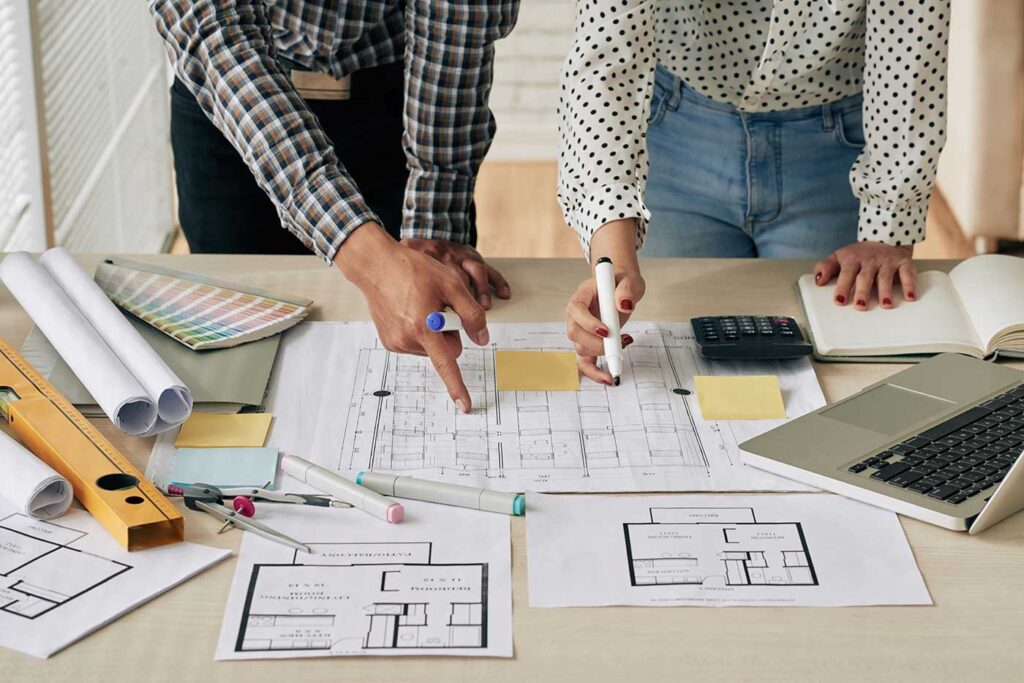
Skip to Section
Most people’s first thought when they see a cameras on construction sites is that they are for security, but there is another type that has a whole different set of uses: construction time-lapse cameras.
Having a live outdoor time-lapse camera overlooking your job site is useful for all kinds of reasons. Why travel to the site when you can open up a web browser on your computer and see exactly what is going on?
By shooting a time lapse video sequence of a construction project, you can build an understanding of the progress of your project as it slowly develops.
Here is an typical example of time-lapse video of the construction of a bridge in the UK:
Construction time lapse camera uses
Marketing
After creating a time-lapse video of the building project, you can showcase it on your company website and social media profiles.
There is no better medium than video and capturing a full construction project in a high quality video is a great way to drive engagement across your social media platforms.
As well as online, you can also use the construction time lapse videos in presentations or play them at marketing exhibitions, which is great pr. There is no better way to capture people’s attention.
Managing projects
You are able to jump to photos from any point in time and even compare photos from two different points in time. This is great for site monitoring and to track the construction projects progress over time and identify when a project is starting to run behind.
Auditing and compliance
The software that accompanies time-lapse construction cameras usually stores an ongoing record of data for auditing and you can download everything to your computer including captured time-lapse photos for the relevant timeframe.
Site security
Of course, time-lapse cameras are equally as good at providing security by surveillance as most dedicated CCTV cameras.
Some are able to detect movement and send you an alert when this happens.
Since time-lapse cameras are typically upload photos to the cloud, there is no risk of someone destroying the camera to get rid of the evidence – everything is safely backed up online.
Choosing a construction time-lapse camera
There are a number of options to choose from when buying a time-lapse camera for construction. So what is the difference between them, and what should you look out for?
Video quality/resolution
You only get one shot at recording a construction industry project, so it’s vitally important that your camera shoots videos of the desired quality.
The video resolution you need depends on your personal requirements. Will the footage be used on your website, or is it just to be viewed internally by your team.
As a general rule, we’d recommend a camera with at least an 8MP (Mega-pixel) sensor and a decent quality C or CS-mount lens.
Weatherproof
Depending on where your camera is going to be located, you may or may not need to make sure it’s fully weatherproof.
Most construction cameras are located outdoors, so even if you plan to mount yours in a sheltered location it’s worth getting a weatherproof camera anyway.
Thinking ahead, you may use it on other projects where the weather protection is necessary.
Photo Storage
As it captures photos, your camera will need somewhere to store them. Usually the camera will have an onboard SD Card or hard drive to store the image files.
The capacity of your drive depends on a number of factors, the main ones being:
- The resolution of your photos
- The duration of your time-lapse projects
- The capture interval
- The image format (usually jpeg or raw)
If your camera uploads photos to the cloud, you may get away with a smaller storage drive but generally, bigger is better. The last thing you want is to run out of storage space, stopping your time-lapse project dead.
Remote access/cloud upload
Most commercially available construction time-lapse cameras these days have some sort of remote access cloud functionality or time-lapse software.
This lets you connect in using a computer, tablet or phone and view photos captured by the camera.
Remote access can be so convenient, much easier than having to physically go to the camera, which can often be half way up the side of a building.
As well as viewing the camera feed, most cloud solutions show you status information for the camera including things like available storage space, battery level (if applicable) and allow you to adjust settings such as capture interval, photo resolution, start/stop schedule etc.
One point to note with regards to cloud connectivity is whether the camera supports 4G/5G, WiFi or ethernet connectivity. Ethernet is best in terms of reliability, speed and price, but it often isn’t available.
4G/5G offer coverage for all but the most remote locations, but 4G is slow and data transfer charges can get expensive.
Solar/battery power options
There are plenty of options when it comes to powering a time-lapse camera, but most time-lapse cameras are powered by a typical mains adaptor which plugs into a standard wall plug or industrial 16A plug.
For projects where power is not available, perhaps in more remote locations, many cameras have a solar panel option which usually mounts above the camera and charges a battery in the camera during the day. During the night, the camera runs from the battery that has charged during daylight hours.
Some cameras, under certain conditions, can run off battery power alone. Providing the camera is low power and the duration of the project is not too long, there are camera options with a large lithium or sealed lead acid battery
Tips for setting up construction time-lapse shoot
There is more that goes in to commercial time-lapse projects than you might think. If just one of these important factors isn’t taken care of, your entire project could be ruined.
Remember, you only get one shot, so give planning and execution the attention they deserve so that you end up with the best result.
Here are some factors to consider for every project. Bear in mind that this list is not exhaustive, but these are some key things you need to consider:
Get Organised
Just like the construction project itself, planning from the very start is essential.

You need to identify as much information about the construction project as possible. Before you start, try to find out:
- Where exactly is the building going to be? Exact width? height?
- When exactly will the project start? do you need to start recording earlier? When is it expected to end? Could it run behind schedule?
- Will the camera need to move at any point? Will the building progress move out of shot at all?
- Where will the camera be mounted? Is it too close/distant? do you need to zoom at all? Where will the sun be during the day? Is there any glare?
- How many frames need to be captured? This will help determine your capture interval.
- Is there mains power at the camera location, or can it be provided? Would a solar panel get enough direct sunlight?
- Does your budget allow for multiple cameras? This could enhance the quality of your end result.
Multiple cameras
Not only does a multiple camera setup allow you to produce more professional time-lapse videos, but it also improves your level of security and ability to effectively audit the progress of your project.
For smaller projects, the higher costs may not be justified, so the number of cameras used depends on your individual needs.
Capture Interval
As with any time-lapse video project, choosing the right capture interval is crucial for a few key reasons.
Too infrequent and the end video whizzes by too fast and the video is too short. Too frequent and the video comes out too slow and boring. Also your storage drive may fill to capacity. If you’re running off battery or solar, you have to consider power consumption of capturing too many photos.
To help you choose the right shutter interval for your project, check out our free time-lapse calculator. The calculator allows you to simply specify how long you plan to record for and how long you want the final video to be and it calculates the recommended capture interval for you.
Bear in mind that if your capture interval is too short, you can speed the resulting video up. As opposed to selecting a too-long shutter interval, then it’s impossible to slow the motion down without it becoming choppy due to low frame rate.
Scheduling Rules
Most good time-lapse camera systems allow you to set scheduling rules. These rules automatically start and stop recording at specific times of the day (and days of the week).
You could set these rules for example to record from 8am to 6pm Monday to Friday, when your construction site is open. There is no point recording overnight if nothing is happening, you are just wasting power and drive space. If you are paying a subscription for a cloud service, you could also be on the hook for significant data transfer and online storage fees too.
Check Regularly
Ask any professional or even seasoned amateur time-lapse photographer and they will have at least a couple of horror stories of time-lapse shoots that ended in disaster for one reason or another.
Don’t ever assume that a camera is capturing good quality photos as it ‘should’. You need to check the captured photos every day and back them up to a safe location regularly.
Some common things that can go wrong and ruin your time-lapse shoot include:
- Power supply problems, damaged/disconnected power cable
- Camera damaged/knocked/disturbed
- Solar panel issues affecting battery charging
- spider web/bugs/debris obscuring lens
- Drive storage space full
- Internet connectivity issues
- Misconfiguration of camera or software settings
There is a lot that can go wrong. If and when something does go wrong, the sooner you know and can address the issue the better.
Composition Is Key
Most people don’t realise just how important composition is for any kind of photography. The angle of your camera, the distance from your subject (the thing you are filming), what other buildings or features are in the shot.
In the planning stages, before you set up your camera, visit the site and take some photos with your smartphone camera. Think about how the final video will look from different angles. It’s worth spending a bit of time finding the perfect spot to mount your camera.
In Conclusion
Don’t forget to send us the result, so that we can share it with our readers!
Pingback: Make Money From TimeLapse Photography - Pro-Lapse
Pingback: Powering a Time-Lapse - Keeping Your DSLR Powered During a Time-Lapse Shoot - Pro-Lapse